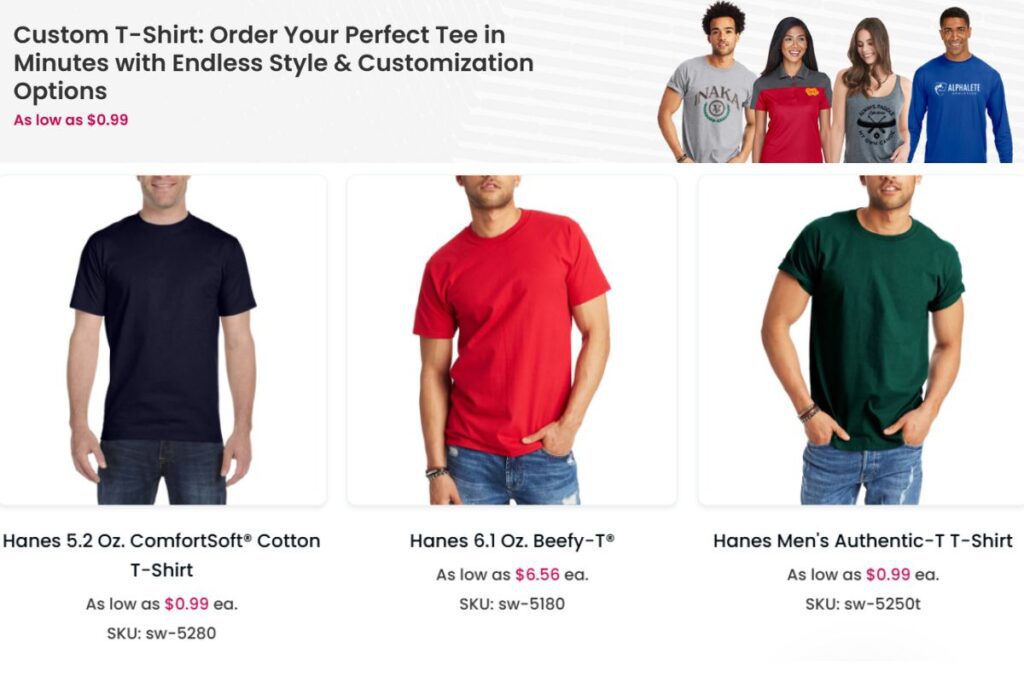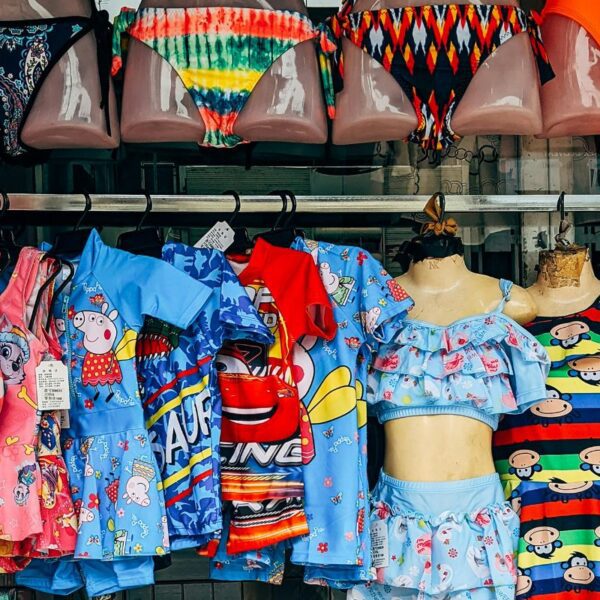Selling clothes on Etsy can be a rewarding experience if you know how to navigate the platform.
To succeed, focus on creating high-quality listings with clear photos, inviting descriptions, and transparent policies. This approach not only attracts buyers but also builds trust in your shop.
Table of contents
Understanding the costs of selling is essential.
You will face listing fees, transaction fees, and payment processing fees when you sell items. Knowing these will help you price your clothes effectively and maintain profitability.
With a strong emphasis on handmade and unique items, Etsy gives you the chance to stand out.
Whether you create your clothes yourself or work with a production partner, being open about your process is crucial. Sharing your story and the care that goes into your products can connect you with customers looking for something special.
Setting Up Your Etsy Shop
Starting your Etsy shop involves key steps that set the foundation for your business.
Focus on creating an account, choosing a memorable shop name, establishing clear policies, and understanding the fees involved. Each step is important to ensure a smooth launch and ongoing success.
Creating Your Etsy Account
To begin, go to Etsy.com and click on “Sign up.”
You will need to provide an email address, create a password, and select a username. This username will become part of your shop’s URL, so choose something memorable related to your brand.
Once signed up, you can start setting up your shop.
You will need to verify your email to activate your account fully. After that, log in and click “Sell on Etsy.” Follow the prompts to set up your shop. This includes inputting your preferences for language, country, and currency. This initial setup is crucial for reaching your target audience.
Choosing Your Shop Name
Your shop name is a key part of your branding. It should reflect the style of your clothing and be easy to remember.
Etsy allows names up to 20 characters with no spaces or special characters. Think about including relevant keywords that describe your products.
Before finalizing, check its availability on Etsy. A good practice is to search for existing shops with similar names. This helps in avoiding confusion and ensures your shop stands out. A unique name can support your marketing efforts and make it easier for customers to find you.
Setting Up Shop Policies
Shop policies clarify your rules for your customers. Policies typically cover shipping, returns, and exchanges. Being clear on these topics prevents misunderstandings and can improve customer trust.
Start by outlining your shipping methods and times. Then, specify your return policy. Will customers get refunds or exchanges? State your policy on damaged items and whether you can offer replacements.
Consider offering international shipping to broaden your customer base. Ensure that your policies are easy to read and accessible on your shop page.
Understanding Etsy Fees
Etsy charges several fees for selling on their platform. Here’s a quick breakdown:
| Fee Type | Amount |
|---|---|
| Listing Fee | $0.20 per item listed |
| Transaction Fee | 6.5% of the sale price |
| Payment Processing Fee | Varies by country |
Each time you create a listing, you will pay a $0.20 fee. When a sale occurs, Etsy takes a transaction fee of 6.5% of the sale amount, including the shipping cost. If you use Etsy Payments, you may face additional processing fees based on where you are located. Being aware of these fees helps you price your items appropriately.
Inventory and Listing Items
| # | Clothing Niche | Why It Sells | Customization Options | Target Audience |
|---|---|---|---|---|
| 1 | Vintage Clothing | High demand for retro styles | Sizing, color restoration | Vintage lovers, collectors |
| 2 | Handmade Dresses | Unique, artisanal appeal | Custom sizing, fabric choices | Women, bridal, events |
| 3 | Personalized T-Shirts | Great for gifts & events | Name, quotes, graphics | Couples, teams, businesses |
| 4 | Tie-Dye Apparel | Trendy and colorful | Custom color combos | Festival-goers, Gen Z |
| 5 | Eco-Friendly Fashion | Sustainable & ethical | Organic fabrics, prints | Green-conscious shoppers |
| 6 | Embroidery Clothing | Handmade, detailed craft | Custom text, designs | Aesthetic fashion lovers |
| 7 | Mom & Baby Matching Sets | Family-friendly & cute | Names, colors, designs | New moms, families |
| 8 | Pet Lover Apparel | Niche market, passionate buyers | Pet names, images | Pet owners & animal lovers |
| 9 | Gothic & Alternative Fashion | Strong subculture market | Unique cuts, dark colors | Goth, punk, alternative crowd |
| 10 | Anime & Pop Culture Tees | Fandom-driven demand | Custom fan art, slogans | Anime, comic, gaming fans |
When selling clothes on Etsy, managing your inventory and creating effective listings is crucial. This involves sourcing your items, crafting product descriptions, and taking strong photographs. Each step helps showcase your unique goods and attracts potential buyers.
Sourcing Inventory
To begin, consider where you will get your clothing items. You can create handmade goods, source from vintage collections, or find eco-friendly options that highlight sustainable fashion. Research local artisans, thrift stores, or wholesalers to find unique items that stand out. Think about trends in fashion on Etsy, such as loungewear, which has gained popularity recently.
Maintaining an organized inventory system is essential. Track which items are available and determine their sizing and fit. Use spreadsheets or inventory management software to ensure efficient stock management.
Listing Your Items
Creating an engaging listing starts with choosing a clear title. Make your product title specific and descriptive. For instance, instead of “Shirt,” use “Handmade Organic Cotton T-Shirt.” Be sure to include key details like materials, sizes, and style.
Etsy charges a listing fee for each item you put up for sale. Keep this in mind when pricing your products. Include all relevant information in the listing to help buyers make informed choices. This enhances their shopping experience and reduces return rates.
Crafting Your Product Descriptions
Your product description is an essential part of the listing. It should provide detailed information about the item. Include the fabric type, care instructions, and how it was made. Highlight benefits, such as eco-friendliness if you offer sustainable fashion products.
Use bullet points for easy readability. Consider mentioning sizing information to help customers choose the right fit. Descriptions should be inviting and reflect your brand’s voice. Be honest about the product to build trust with potential buyers.
Photographing Your Clothing
Strong photographs are key to attracting customers. Take high-quality images with good lighting and clarity. Use natural light when possible, and avoid cluttered backgrounds. Show the clothing from multiple angles. Include close-ups to highlight details like stitching or patterns.
Consider styling the clothes on models or mannequins to help buyers visualize how they would look when worn. It’s important to accurately represent the color and fit of the item. Better photos can often lead to more sales, so invest time in this step.
Optimizing Your Listings
To attract buyers on Etsy, you must optimize your listings effectively. This involves applying solid SEO strategies and utilizing relevant keywords in your titles and descriptions. These steps can significantly improve your visibility and increase sales.
Applying SEO Strategies
Etsy SEO focuses on making your listings more discoverable. Start by crafting clear, concise titles that reflect what you sell. Aim for around 40 characters, leading with relevant keywords. For example, instead of “Cool Summer Dress,” try “Comfortable Blue Summer Dress.”
Next, fill out all your product details. Make use of every available field, including tags. Tags should include variations and related terms, like “boho dress” or “casual summer wear.”
Quality images are also critical. Use well-lit photos from multiple angles. This not only improves your listing but also helps build trust with potential buyers.
Utilizing Keywords
Keywords play a vital role in optimizing your listings. Research which terms buyers use most often when searching for clothes similar to yours. Tools like Etsy’s search bar can reveal popular phrases.
Once you identify keywords, incorporate them throughout your listing. Place them in your title, description, and tags. Make sure they sound natural and relevant.
For example, if you sell “handmade cotton scarves,” use this phrase multiple times in your description but don’t overdo it. Aim for balance, so your text remains readable.
Regularly update your keywords based on trends and seasonal demand to maintain visibility and attract more shoppers.
Pricing and Shipping
| Item Type | Shipping Cost (Domestic – USA) | International Shipping |
|---|---|---|
| T-Shirts | $3.50 – $6.00 | $10 – $20 |
| Hoodies | $7.50 – $12.00 | $15 – $30 |
| Dresses | $5.00 – $10.00 | $12 – $25 |
| Handmade Items | $6.00 – $12.00 | $15 – $35 |
| Bulk Orders (2-3 items) | $8.00 – $15.00 | $20 – $40 |
Setting the right prices and shipping costs is essential for your success on Etsy. You want to cover your costs while attracting buyers. Here are some important aspects to consider.
Calculating Your Prices
To determine your prices, start by adding up all your costs, including materials, labor, and fees. Etsy charges a transaction fee of 6.5% on each sale, plus a $0.20 listing fee.
Use this formula to calculate your price:
- Total Costs: Add material costs + labor + transaction fees.
- Desired Profit: Decide how much profit you want to make.
- Final Price: Total costs + desired profit.
Setting Shipping Costs
Shipping costs can greatly affect your sales. Use Etsy’s shipping calculator to set accurate rates. Consider the following when calculating shipping:
- Package Weight and Size: Know your product dimensions to avoid surprises.
- Shipping Method: Choose between USPS or FedEx based on pricing and delivery times.
- Discounts: Offer free shipping or flat rates to entice customers.
Keep an eye on shipping prices, as offering competitive rates can boost sales. You can also factor shipping costs into your product price, making it easier for buyers to choose your items. Always update your shipping policy for international orders to avoid misunderstandings.
Marketing Your Etsy Shop

Effective marketing is crucial for your Etsy shop’s success. You can reach a wider audience by leveraging social media, utilizing Etsy’s promotional tools, and collaborating with influencers. Here’s how to get started.
Leveraging Social Media
Social media is a powerful way to promote your Etsy shop. Platforms like Instagram, Facebook, and Pinterest allow you to showcase your clothing items visually.
- Create Engaging Content: Post high-quality images of your products. Use stories and reels to share behind-the-scenes looks or styling tips.
- Use Hashtags: Include relevant hashtags to increase your visibility. Popular tags for clothing include #EtsyFashion and #HandmadeClothes.
- Engage with Followers: Respond to comments and messages promptly. Building relationships can lead to repeat customers.
Consider running targeted ads on these platforms to reach specific demographics that fit your brand, increasing traffic to your shop.
Utilizing Etsy Promotional Tools
Etsy offers several promotional tools that can help boost your visibility.
- Promoted Listings: You can pay to have your items featured higher in search results. This captures the attention of potential buyers who are ready to purchase.
- Etsy Ads: With Etsy Ads, you set a daily budget for advertisements. This allows your products to be seen by more users within the Etsy platform.
- Offsite Ads: These ads showcase your items on other websites. If customers make a purchase through these ads, Etsy charges a small fee only from the sale.
Regularly review performance in your shop manager to see which tools work best for you.
Collaborating with Influencers
Working with influencers can significantly enhance your shop’s reach. Partnering with the right influencers can introduce your clothing line to a larger audience.
- Find the Right Match: Look for influencers who align with your brand’s aesthetic and values. Their audience should also fit your target market.
- Create Authentic Content: Allow influencers creative freedom to style your clothes. Authentic recommendations resonate better and build trust.
- Track Engagement: Use unique discount codes or trackable links to see how much traffic and sales come from each influencer.
Effective collaborations can lead to increased visibility and credibility for your Etsy shop, driving both traffic and sales.
Managing Customer Interactions
| Interaction Type | Best Practices | Response Time |
|---|---|---|
| Pre-Sale Inquiries (Sizing, customization, shipping) | Provide clear & friendly responses. Offer size charts, material details, and estimated shipping times. | Within 24 hours |
| Order Confirmation Messages | Send a thank-you note & confirm the estimated shipping date. | Immediately after purchase |
| Shipping & Tracking Updates | Update customers with tracking info. If delayed, inform them proactively. | Once shipped |
| Handling Returns & Refunds | Be polite and refer to shop policies. Offer solutions (replacement, refund, or store credit). | Within 24 hours |
| Handling Negative Reviews | Stay calm, apologize for the issue, and offer a resolution. Request a review update if resolved. | Within 48 hours |
| Positive Review Engagement | Thank the customer for their feedback and encourage them to return. | As soon as possible |
| Custom Order Requests | Confirm details, price, and estimated processing time before starting. | Within 24 hours |
| Dealing with Difficult Customers | Stay professional, avoid emotional responses, and offer reasonable solutions. | Within 24-48 hours |
| Managing Etsy Messages (Inbox Management) | Set up quick response templates for FAQs. Prioritize urgent messages first. | Daily check-ins recommended |
Strong customer interactions are key to running a successful Etsy shop. By focusing on excellent service and clear communication, you can build trust with online shoppers and keep them coming back.
Providing Excellent Customer Service
To succeed, you need to prioritize customer service.
Responding to questions quickly shows customers you value their time. Aim to reply within 24 hours.
Here are a few service tips:
- Be Polite and Professional: Always greet customers warmly.
- Be Clear: Use simple language to avoid misunderstandings.
- Follow Up: After a purchase, send a thank you message to show appreciation.
This builds a positive shopping experience and encourages customer loyalty.
Happy customers are more likely to leave good reviews, which can attract new buyers to your shop.
Handling Order Inquiries
Order inquiries can range from product questions to shipping details. Addressing these inquiries with care is important for maintaining customer satisfaction.
Consider these practices:
- Create an FAQ Page: This can answer common questions and reduce repetitive inquiries.
- Stay Informed: Know your product details and shipping policies well to provide accurate information.
- Be Patient: Understand that customers may have many concerns. Take the time to answer them thoroughly.
By managing inquiries effectively, you foster a positive relationship with customers.
This not only helps resolve issues but also makes online shoppers feel valued and understood.
Analyzing Your Performance

Analyzing your performance on Etsy is crucial for success. By evaluating sales data and adjusting your strategies, you can optimize your shop for better results.
Evaluating Sales Data
Start by tracking your sales data using Etsy’s built-in analytics tools.
Focus on key metrics like:
- Conversion Rate: This tells you how many visitors purchase items. A low rate may indicate the need for better photos or descriptions.
- Traffic Sources: Know where your visitors come from. Is it Etsy search, social media, or Etsy Ads? This helps in directing your marketing efforts effectively.
- Top-Selling Items: Identify which clothes sell best. Expanding similar products can increase your sales.
Regularly review this data to spot trends.
For instance, if winter coats are popular, consider listing more winter apparel.
Using tools like the Etsy analysis tool can provide deeper insights into your sales.
Adjusting Strategies Based on Insights
Once you have evaluated your data, it’s time to adjust your strategies.
Start with your listings. Update photos and descriptions based on what resonates most with buyers.
Consider using bold and clear titles to enhance visibility in search results.
Also, leverage paid advertising through Etsy Ads.
Track your ad performance and modify your budget accordingly. If certain keywords work well, consider focusing more on them.
Finally, engage with your customers. Their feedback is valuable.
Ask for reviews and use them to improve your offerings.
By continuously refining your strategies, your Etsy shop can become a thriving online business.
Scaling Your Etsy Business
| Strategy | How to Achieve It | Expected Impact |
|---|---|---|
| Expand Product Line | Introduce new variations, seasonal collections, or complementary items. | Increases sales opportunities & attracts a wider audience. |
| Optimize Listings | Use high-quality images, detailed descriptions, and SEO-friendly titles & tags. | Improves search rankings and visibility. |
| Offer Customization | Personalize products based on customer preferences. | Enhances customer experience & boosts repeat purchases. |
| Leverage Social Media | Promote on Instagram, Pinterest, and TikTok with engaging content & ads. | Drives traffic to your Etsy shop and increases brand awareness. |
| Run Etsy Ads | Invest in Etsy’s paid ads to target high-intent buyers. | Increases visibility and sales, especially for new listings. |
| Provide Excellent Customer Service | Respond promptly to inquiries, resolve issues, and engage with buyers. | Builds customer trust and loyalty, leading to positive reviews. |
| Create Bundles & Discounts | Offer product bundles or discounts for bulk purchases. | Encourages larger orders and increases average order value (AOV). |
| Expand to Other Marketplaces | Sell on platforms like Shopify, Amazon Handmade, or your own website. | Diversifies revenue streams and reduces reliance on Etsy. |
| Improve Order Fulfillment | Streamline production, partner with fulfillment services, or outsource packaging. | Increases efficiency and allows you to handle more orders. |
| Engage with Email Marketing | Collect emails and send promotions, product updates, and discounts. | Keeps customers engaged and drives repeat sales. |
To grow your Etsy clothing shop, focus on expanding your product lines and exploring international markets. These strategies can help you reach new customers and increase sales.
Expanding Product Lines
To attract more buyers, consider adding a variety of clothing options.
Start with fashion-forward pieces and everyday staples that cater to different needs.
For instance, if you sell dresses, consider adding tops, bottoms, and outerwear.
Incorporate trends like runway-worthy looks that can catch the eye of fashion enthusiasts.
Use customer feedback to identify what people want. You can also create seasonal collections or themed items to keep your shop fresh.
Regularly updating your inventory will encourage repeat visits and boost your shop’s visibility on Etsy.
Exploring International Markets
Selling internationally opens your shop to a wider audience.
Start by offering international shipping options to various countries.
Understand the sizing equivalents for different regions, as this can prevent confusion and returns.
Make it easy for international customers to shop by providing clear shipping policies and estimated delivery times.
You may also want to localize your listings with translations if possible.
This can help build trust with customers who may be hesitant to shop from overseas sellers.
Always research your target markets to tailor your offerings accordingly for maximum appeal.
Frequently Asked Questions
Selling clothes on Etsy involves understanding the platform’s rules and market. You may have specific questions about what can be sold, costs, and best practices. Below are answers to common concerns.
Can I sell used clothes on Etsy?
Yes, you can sell used clothes on Etsy. However, you must categorize them as vintage items.
Vintage clothes should be at least 20 years old. Make sure to provide clear descriptions and honest details about their condition.
Is selling clothes on Etsy worth it?
Selling clothes on Etsy can be worthwhile if you target the right audience.
Unique, handmade, or vintage items can attract buyers. Research popular trends and your competition to gauge potential success.
Does clothing sell well on Etsy?
Clothing can sell well on Etsy, especially if it’s unique or custom-made.
Categories like bridal wear, jewelry, and home decor tend to perform strongly. You should present high-quality images and detailed descriptions to draw in customers.
How much does it cost to sell clothes on Etsy?
To sell clothes on Etsy, you’ll need to pay a listing fee of $0.20 for each item.
Additionally, there is a 6.5% transaction fee on the sale price. Consider these costs when pricing your items to ensure profitability.
How to sell on Etsy for beginners?
As a beginner, start by setting up your Etsy account and creating a shop.
Take clear photos of your clothing and write detailed descriptions.
Promote your shop on social media and engage with potential customers to grow your visibility.
What are the best practices for setting up an Etsy seller account for a clothing shop?
For a clothing shop, choose a shop name that reflects your brand.
Provide informative shop policies regarding shipping and returns.
Regularly update your listings and respond to customer inquiries promptly to build trust and enhance your reputation.




